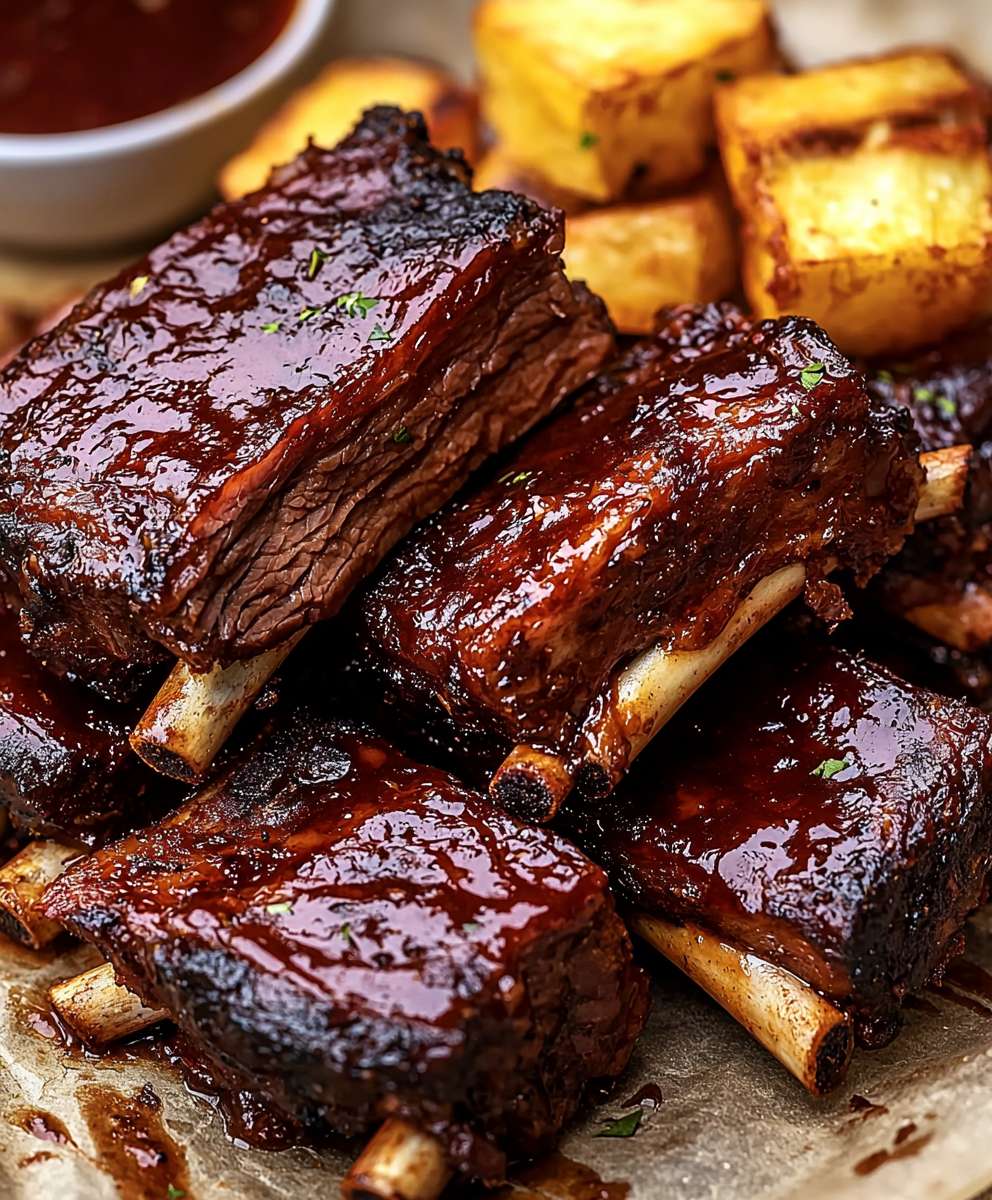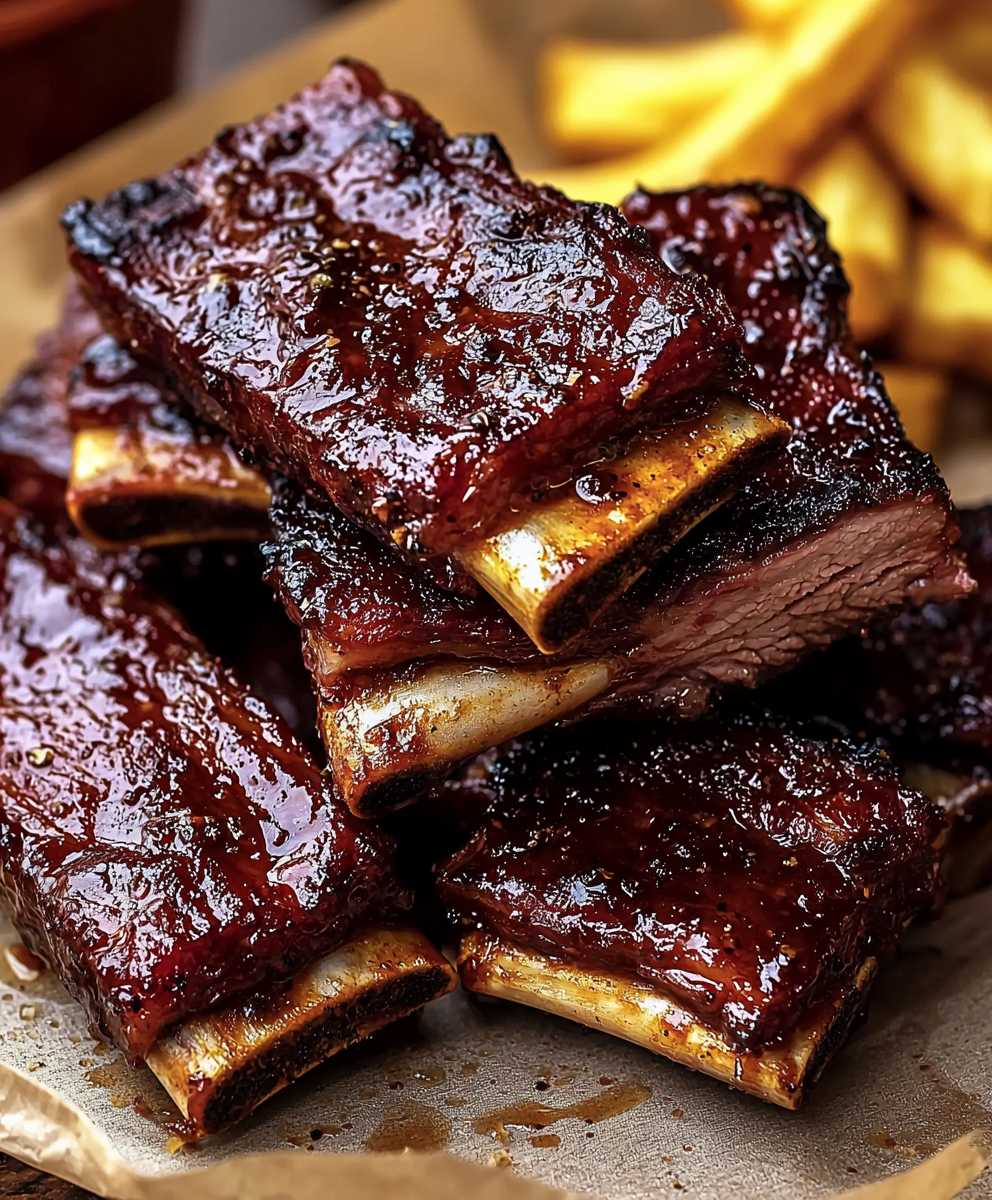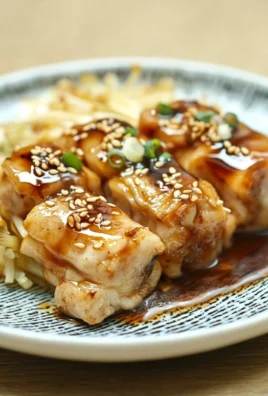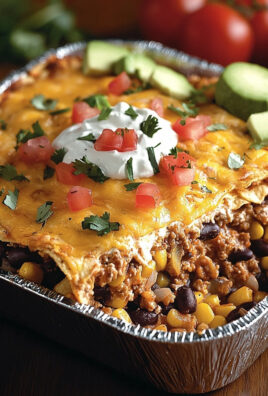Smoked beef short ribs: just the name conjures up images of tender, smoky meat falling off the bone, doesn’t it? I’m thrilled to share my tried-and-true recipe for achieving barbecue perfection right in your own backyard. Forget those tough, chewy ribs you might have encountered before. This method guarantees succulent, melt-in-your-mouth goodness every single time.
Beef short ribs have a rich history, often featuring prominently in various culinary traditions around the world. From Korean Kalbi to braised dishes in European cuisine, these flavorful cuts have been cherished for generations. The beauty of smoked beef short ribs lies in their ability to absorb the smoky flavors, transforming them into a truly unforgettable experience. The low and slow cooking process renders the fat, creating an incredibly tender and juicy result that’s simply irresistible.
People adore smoked beef short ribs for a multitude of reasons. The deep, smoky flavor is a major draw, of course, but it’s also the satisfying texture the perfect balance of tender meat and slightly crisp bark that keeps everyone coming back for more. Plus, while the smoking process requires some time, it’s largely hands-off, allowing you to relax and enjoy the day while your smoker works its magic. Get ready to impress your friends and family with this show-stopping dish!
Ingredients:
- Beef Short Ribs: 4-5 lbs, preferably plate short ribs (also known as dino ribs) for maximum meat and flavor. Look for ribs with good marbling.
- Dry Rub:
- Coarse Ground Black Pepper: 1/4 cup
- Kosher Salt: 1/4 cup
- Granulated Garlic: 2 tablespoons
- Onion Powder: 2 tablespoons
- Smoked Paprika: 1 tablespoon
- Brown Sugar: 1 tablespoon (optional, for a touch of sweetness)
- Cayenne Pepper: 1 teaspoon (optional, for a little heat)
- Binder (Optional):
- Yellow Mustard: A thin layer to help the rub adhere.
- Worcestershire Sauce: Another option for a savory binder.
- Wood for Smoking:
- Oak: A classic choice for beef, providing a strong, smoky flavor.
- Hickory: Another good option, offering a slightly sweeter smoke.
- Pecan: A milder, nuttier smoke that complements beef well.
- Spritz (Optional):
- Apple Cider Vinegar: 1 cup
- Water: 1 cup
Preparing the Beef Short Ribs:
- Trim the Ribs: This is a crucial step. Beef short ribs often have a thick layer of fat on top. While some fat is desirable for flavor and moisture, too much can prevent the rub from penetrating the meat and can result in a greasy final product. Using a sharp knife, carefully trim away excess fat, leaving about 1/4 inch of fat cap. Also, remove any silverskin (a thin, tough membrane) from the bone side of the ribs. This will allow the rub to adhere better and prevent the ribs from curling during cooking.
- Apply the Binder (Optional): If you’re using a binder, lightly coat the ribs with either yellow mustard or Worcestershire sauce. Don’t overdo it; you just want a thin layer to help the rub stick. The mustard flavor will cook out during the smoking process, leaving no mustard taste behind.
- Mix the Dry Rub: In a bowl, combine the coarse ground black pepper, kosher salt, granulated garlic, onion powder, smoked paprika, brown sugar (if using), and cayenne pepper (if using). Mix well to ensure all the ingredients are evenly distributed.
- Apply the Dry Rub: Generously coat all sides of the ribs with the dry rub. Press the rub into the meat to help it adhere. Don’t be shy; you want a good, even coating. I like to use my hands for this, ensuring every nook and cranny is covered.
- Rest the Ribs: After applying the rub, wrap the ribs tightly in plastic wrap and refrigerate them for at least 2 hours, or preferably overnight. This allows the rub to penetrate the meat and develop a deeper flavor. If you’re short on time, even an hour in the refrigerator will help.
Setting Up the Smoker:
- Choose Your Smoker: You can use a variety of smokers for this recipe, including a pellet smoker, a charcoal smoker, or an offset smoker. Each type of smoker has its own advantages and disadvantages, so choose the one that you’re most comfortable with. I personally prefer an offset smoker for the authentic smoky flavor it imparts.
- Prepare the Smoker: Clean your smoker thoroughly before starting. Remove any old ash or debris. Fill the fuel source (pellets, charcoal, or wood) according to your smoker’s instructions.
- Preheat the Smoker: Preheat your smoker to 250°F (121°C). Maintaining a consistent temperature is crucial for smoking ribs properly. Use a reliable thermometer to monitor the temperature inside the smoker. If you’re using a charcoal smoker, you may need to adjust the vents to control the temperature.
- Add Wood for Smoke: Once the smoker reaches the desired temperature, add your chosen wood for smoke. If you’re using wood chunks, place them directly on the coals or in the smoker box. If you’re using wood chips, soak them in water for about 30 minutes before adding them to the smoker. This will help them smolder and produce more smoke.
- Stabilize the Temperature: Allow the smoker to stabilize at 250°F (121°C) for at least 30 minutes before adding the ribs. This will ensure that the temperature is consistent and that the ribs will cook evenly.
Smoking the Beef Short Ribs:
- Place the Ribs in the Smoker: Once the smoker is preheated and the temperature is stable, remove the ribs from the refrigerator and unwrap them. Place the ribs directly on the smoker grate, bone-side down. Make sure there is enough space between the ribs to allow for proper airflow.
- Maintain the Temperature: Maintain the smoker temperature at 250°F (121°C) throughout the smoking process. Check the temperature regularly and adjust the vents or add more fuel as needed. Consistency is key to achieving tender, juicy ribs.
- Spritz the Ribs (Optional): After about 3 hours of smoking, begin spritzing the ribs with apple cider vinegar and water mixture every hour. This will help keep the ribs moist and prevent them from drying out. The spritz also adds a subtle tanginess to the flavor.
- Check for Doneness: The ribs are done when they reach an internal temperature of around 203°F (95°C) and are probe tender. This typically takes about 6-8 hours, but it can vary depending on the size and thickness of the ribs, as well as the consistency of your smoker’s temperature. Use a meat thermometer to check the internal temperature. Probe tenderness is determined by inserting a thermometer or probe into the thickest part of the meat; it should slide in with little to no resistance.
Wrapping the Ribs (Texas Crutch – Optional):
- Prepare the Wrapping Material: If you choose to wrap the ribs (the “Texas Crutch”), you’ll need heavy-duty aluminum foil or butcher paper. I prefer butcher paper because it allows the ribs to breathe slightly, preventing them from becoming too mushy.
- Wrap the Ribs: Once the ribs have developed a good bark (a dark, flavorful crust), usually after about 4-5 hours of smoking, remove them from the smoker and wrap them tightly in the foil or butcher paper. You can add a tablespoon of beef broth or melted butter to the wrapping for extra moisture and flavor.
- Return to the Smoker: Place the wrapped ribs back in the smoker and continue cooking until they reach an internal temperature of around 203°F (95°C) and are probe tender. This typically takes another 2-3 hours.
Resting and Serving:
- Rest the Ribs: Once the ribs are done, remove them from the smoker and let them rest for at least 1 hour, or preferably 2 hours, before slicing and serving. This allows the juices to redistribute throughout the meat, resulting in a more tender and flavorful final product. You can wrap the ribs in a towel and place them in a cooler to keep them warm during the resting period.
- Slice and Serve: After resting, unwrap the ribs and slice them between the bones. Serve immediately and enjoy! These smoked beef short ribs are delicious on their own, or you can serve them with your favorite barbecue sides, such as coleslaw, potato salad, and baked beans.

Conclusion:
So, there you have it! This recipe for smoked beef short ribs is more than just a meal; it’s an experience. From the tantalizing aroma that fills your backyard to the melt-in-your-mouth tenderness of the beef, every step of the process is a journey worth taking. I truly believe this is a must-try recipe for any BBQ enthusiast, whether you’re a seasoned pitmaster or just starting out with your smoker.
Why is it a must-try, you ask? Because it delivers that authentic, smoky flavor that you simply can’t achieve any other way. The combination of the dry rub, the low and slow smoking process, and the final braise creates a symphony of flavors and textures that will leave you craving more. Forget tough, chewy ribs these are fall-off-the-bone tender, juicy, and packed with that rich, beefy goodness that only smoked short ribs can provide. Trust me, your family and friends will be singing your praises!
Now, let’s talk serving suggestions and variations. While these smoked beef short ribs are incredible on their own, there are countless ways to enjoy them. For a classic BBQ experience, serve them with your favorite sides like creamy coleslaw, potato salad, baked beans, and cornbread. A tangy BBQ sauce on the side is always a welcome addition, but honestly, they’re so flavorful that they don’t even need it!
But don’t stop there! Get creative and explore different ways to use these delicious ribs. Shred the meat and use it to make mouthwatering tacos or sliders. Add it to a hearty chili for an extra layer of smoky flavor. Or, toss it with pasta and a rich tomato sauce for a truly decadent meal. The possibilities are endless!
Here are a few variations you might want to consider:
- Spice it up: Add a pinch of cayenne pepper or some chili flakes to the dry rub for a little extra heat.
- Experiment with wood: Try different types of wood chips to create unique flavor profiles. Hickory, mesquite, and applewood are all great options.
- Braised in beer: Instead of beef broth, braise the ribs in your favorite dark beer for a richer, more complex flavor.
- Coffee rub: Add finely ground coffee to your dry rub for a unique and bold flavor.
I’m so excited for you to try this recipe and experience the magic of smoked beef short ribs for yourself. I’ve poured my heart and soul into perfecting this recipe, and I’m confident that you’ll love it as much as I do.
So, fire up your smoker, gather your ingredients, and get ready to create a BBQ masterpiece. And most importantly, don’t forget to share your experience with me! I’d love to hear how your ribs turned out, what variations you tried, and what sides you served them with. You can leave a comment below, tag me on social media, or send me an email. I can’t wait to see your creations!
Happy smoking, and enjoy!
Print
Smoked Beef Short Ribs: The Ultimate Guide to Tender, Smoky Perfection
- Total Time: 600 minutes
- Yield: 4-5 servings
Description
Tender, juicy, and flavorful Smoked Beef Short Ribs (dino ribs) with a perfect smoky bark. A BBQ delicacy.
Ingredients
- Beef Short Ribs: 4-5 lbs, plate short ribs (dino ribs) preferred
- Coarse Ground Black Pepper: 1/4 cup
- Kosher Salt: 1/4 cup
- Granulated Garlic: 2 tablespoons
- Onion Powder: 2 tablespoons
- Smoked Paprika: 1 tablespoon
- Brown Sugar: 1 tablespoon (optional)
- Cayenne Pepper: 1 teaspoon (optional)
- Yellow Mustard: Thin layer
- Worcestershire Sauce: Thin layer
- Oak
- Hickory
- Pecan
- Apple Cider Vinegar: 1 cup
- Water: 1 cup
Instructions
- Trim the Ribs: Trim excess fat from the ribs, leaving about 1/4 inch fat cap. Remove silverskin from the bone side.
- Apply Binder (Optional): Lightly coat ribs with yellow mustard or Worcestershire sauce.
- Mix Dry Rub: Combine black pepper, salt, garlic powder, onion powder, smoked paprika, brown sugar (if using), and cayenne pepper (if using).
- Apply Dry Rub: Generously coat all sides of the ribs with the dry rub, pressing it into the meat.
- Rest the Ribs: Wrap ribs tightly in plastic wrap and refrigerate for at least 2 hours, or preferably overnight.
- Choose Your Smoker: You can use a variety of smokers for this recipe, including a pellet smoker, a charcoal smoker, or an offset smoker.
- Prepare the Smoker: Clean your smoker thoroughly before starting. Remove any old ash or debris. Fill the fuel source (pellets, charcoal, or wood) according to your smoker’s instructions.
- Preheat the Smoker: Preheat your smoker to 250°F (121°C). Use a reliable thermometer to monitor the temperature inside the smoker. If you’re using a charcoal smoker, you may need to adjust the vents to control the temperature.
- Add Wood for Smoke: Once the smoker reaches the desired temperature, add your chosen wood for smoke. If you’re using wood chunks, place them directly on the coals or in the smoker box. If you’re using wood chips, soak them in water for about 30 minutes before adding them to the smoker. This will help them smolder and produce more smoke.
- Stabilize the Temperature: Allow the smoker to stabilize at 250°F (121°C) for at least 30 minutes before adding the ribs. This will ensure that the temperature is consistent and that the ribs will cook evenly.
- Place the Ribs in the Smoker: Place the ribs directly on the smoker grate, bone-side down. Ensure proper airflow between the ribs.
- Maintain the Temperature: Maintain the smoker temperature at 250°F (121°C). Check and adjust as needed.
- Spritz the Ribs (Optional): After 3 hours, spritz with apple cider vinegar and water mixture every hour.
- Check for Doneness: Cook until the internal temperature reaches 203°F (95°C) and are probe tender, about 6-8 hours.
- Prepare the Wrapping Material: If you choose to wrap the ribs (the “Texas Crutch”), you’ll need heavy-duty aluminum foil or butcher paper.
- Wrap the Ribs: Once the ribs have developed a good bark (a dark, flavorful crust), usually after about 4-5 hours of smoking, remove them from the smoker and wrap them tightly in the foil or butcher paper. You can add a tablespoon of beef broth or melted butter to the wrapping for extra moisture and flavor.
- Return to the Smoker: Place the wrapped ribs back in the smoker and continue cooking until they reach an internal temperature of around 203°F (95°C) and are probe tender. This typically takes another 2-3 hours.
- Rest the Ribs: Rest the ribs for at least 1 hour, or preferably 2 hours, before slicing. Wrap in a towel and place in a cooler to keep warm.
- Slice and Serve: Slice between the bones and serve.
Notes
- Trimming the fat is crucial for a good bark and prevents a greasy result.
- Resting the ribs is essential for tender, juicy meat.
- Wrapping (Texas Crutch) speeds up the cooking process and can help with tenderness, but it can soften the bark.
- Use a reliable meat thermometer for accurate temperature readings.
- Adjust smoking time based on the size and thickness of the ribs and your smoker’s performance.
- Prep Time: 30 minutes
- Cook Time: 360 minutes




